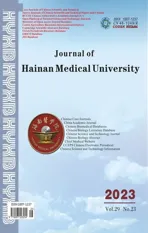Compound fufangteng mixture affects the expression of CD69 on CD11b + monocytes in immunosuppressed mice
2023-03-06DINGJianCHENGuoLIJianmingLIKaiqiYANGChenyiWUYuerong
DING Jian , CHEN Guo, LI Jian-ming, LI Kai-qi, YANG Chen-yi, WU Yue-rong
1. Guangxi University of Tradit Chin Med, Nanning 530200, China
2. Department of Spleen and Stomach Diseases, Hubei Provincial Hospital of Tradit Chin Med, Wuhan 430060, China
Keywords:
ABSTRACT Objective: To investigate the effects of Compound Fufangteng Mixture (CFM) on the expression levels of CD11b+ monocytes surface activation molecules CD2, CD69 and depleted molecules PD-1 and CD95 in spleen and peripheral blood of immunosuppressed mice.Methods: 30 healthy SPF Balb/c male mice were randomly divided into Control,immunosuppressive model group (CTX group), high, medium and low dose intervention group (CTX+CFM-H group, CTX+CFM-M group, CTX+CFM-L group), Astragalus particles(AP) intervention group (CTX+AP group).The mice in each intervention group were injected intraperitoneally with cyclophosphamide (CTX) 70 mg/kg for 3 consecutive days, and then administered for 10 d according to the group regimen, and the materials were taken 24 h after the last dose.Flow cytometry detected the expression of CD11b+ monocytes surface activation molecules (CD2, CD69) and depleting molecules (PD-1, CD95) in mouse peripheral blood.Results: Compared with the control group, the expression levels of CD11b+ and CD69+ in the spleen of CTX+CFM-H, CTX+CFM-M and CTX+CFM-L groups showed an improvement trend, and decreased with the dose gradient of CFM.Conclusion: CFM could regulate the immune function of splenic CD11b+ CD69 cells in immunosuppressed mice.
1.Introduction
Compound Fufangteng Mixture (CFM) is a characteristic Chinese patent medicine in Guangxi Zhuang Autonomous Region.It takes fufangteng as the monarch, astragalus membranaceus and red ginseng as the minister.It has the effects of tonifying qi and nourishing blood, invigorating spleen and nourishing heart, and mainly treats qi and blood deficiency, heart and spleen deficiency[1-3].Studies have shown that CFM has a mobilization effect on rat bone marrow derived mesenchymal stem cells ( BMSCs) and can promote the proliferation of rat BMSCs[4-6].CFM can improve the learning and memory ability of model mice[7].It also can play an anti-aging role by improving the body ‘s immune ability and antioxidant capacity[8,9].Our previous studies have found that CFM can regulate the immune function of CD3-CD49b+NK cells in cyclophosphamide ( CTX ) immunosuppressed mice[10] and increase lymphocyte transformation rate and macrophage phagocytosis rate[11].However, whether it regulates the immune mechanism of monocytes is still unclear.As an important part of the immune system, monocytes play an important role in the immune response.In this study, CTX-induced immunosuppressive mice model was prepared.Flow cytometry was used to observe the expression of CD2, CD69, PD-1 and CD95 on the surface of CD11b+monocytes in spleen and peripheral blood of immunosuppressive mice, and to further explore the mechanism of CFM regulating immunity.
2.Materials and methods
2.1 Materials
2.1.1 Experimental animals
Thirty SPF Balb / c male mice, aged 42~62 days, weighing ( 20± 2 ) g, were purchased from Beijing Weitong Lihua Experimental Animal Technology Co., Ltd., with animal production license number : SCXK ( Beijing ) 2016-0006.Free to drink and eat,adaptive feeding for 1 week.
2.1.2 Main instruments
Cell counter ( Bio-Rad, TC20, USA ).high-end analytical flow cytometer ( BD, BD LSRFortessa, USA ).thermoFisher ( ST16R )Desktop High Speed Freezing Centrifuge.
2.1.3 Main reagents
Compound Fufangteng Mixture was donated to Bainianle Pharmaceutical Factory affiliated to Guangxi University of Tradit Chin Med ( Sinopharm Z4502181 ).huang Qi granules were purchased from Nanjing Tongrentang Pharmaceutical Co., Ltd.( Z20113052 ).cyclophosphamide was purchased from Jiangsu Hengrui Pharmaceutical Co., Ltd.( H32020857 ).mouse peripheral blood and spleen tissue lymphocyte separation kit was purchased from Solarbio.CD11b, CD2, CD69, PD-1 and CD95 flow antibodies were purchased from BD, USA.
2.2 Experimental methods
2.2.1 Experimental grouping and model preparation[10]
Thirty mice were randomly divided into 6 groups : blank group( Control ), immunosuppressive model group ( CTX group ),Compound Fufangteng Mixture high, medium and low dose intervention group ( CTX + CFM-H group, CTX + CFM-M group,CTX + CFM-L group ), Astragalus particles ( AP ) intervention control group ( CTX + AP group ), 5 mice in each group.
CTX-induced immunosuppression model referred to the previous modeling method of the research group.The model group, the experimental group and the positive control group were intraperitoneally injected with CTX ( 70 mg/kg ) on the first to third days of the experiment, and the blank control group was intraperitoneally injected with the same dose of normal saline.
2.2.2 Administration and sampling method
Each intervention group began to give medicine after modeling, and the administration time was 10 d.CTX + CFM-H group was given CFM 15 g/kg by gastric feeding, qd.cTX + CFM-M group was given CFM 7.5 g/kg, qd.cTX + CFM-L group was given CFM 3.75 g/kg, qd.cTX + AP group was given Astragalus membranaceus 5 g/kg, qd.control group and CTX group were fed with normal saline 0.15 mL/10 g, qd.All animals began to eat and drink freely at 8:30 every day.
After the last administration, anesthesia was performed, eyeballs were removed for blood collection, spleen tissues were taken and weighed and ground.Mononuclear cells were isolated from peripheral blood and spleen of mice by lymphocyte separation medium.According to the results of cell counting, 50 μL cell suspension was prepared at a concentration of 1 × 104cells / μL for inspection.
2.2.3 Flow cytometry was used to detect the expression of CD11b, CD2, CD69, PD-1 and CD95[12,13].
50 μL of pre-configured mononuclear cell suspension was added with 1 μL of CD11b, CD2, CD69, PD-1 and CD95 antibodies,respectively.Incubated at 4 ℃ in dark for 30 min, centrifuged,discarded the supernatant and added 500 μL PBS containing 1 %paraformaldehyde diluent to re-suspend the cells, and detected by flow cytometry.Spleen tissue and peripheral blood mononuclear cells were selected by FSC and SSC, and CD11b was set from the selected cells according to the labeled fluorescence, and then CD2,CD69, PD-1 and CD95 positive cells were circled from CD11b+cells( Fig.1 ).
2.2.4 Statistical analysis
GraphPad 8.0 statistical software was used to analyze the experimental data.The experimental data were expressed as mean± standard deviation (±s ).The data conforming to the normal distribution were analyzed by independent sample t test or variance analysis, and the data not conforming to the normal distribution were analyzed by rank sum test.The significance level was set as*P < 0.05,**P < 0.01,***P < 0.001 to determine whether the data difference was statistically significant.
3.Results
3.1 Expression of CD2 and CD69 on CD11b+ cells in peripheral blood of mice
As shown in Fig.2 and Table 1, there was no significant difference in the ratio of CD11b+monocytes in peripheral blood of mice among the groups ( P > 0.05 ).The expression trend of CD69 on CD11b+monocytes in peripheral blood of mice showed that the expression of CD69 on CD11b+monocytes in CTX + CFM-M group was significantly higher than that in CTX group, but there was no statistical difference ( P = 0.89 ).There was no significant difference in the expression level of CD2 on CD11b+monocytes among the groups ( P > 0.05 ).
There was no statistical difference between each group and the model group.There was no statistical difference between each group and the control.
3.2 The expression of PD-1 and CD95 on the surface of CD11b+ cells in peripheral blood of mice
As shown in Fig.3 and Table 2, there was no significant difference in the ratio of peripheral blood CD11b+monocytes in each group( P > 0.05 ).The expression trend of PD-1 on CD11b+monocytes in peripheral blood of mice showed that the expression of PD-1 on CD11b+monocytes in CTX + CFM-M group was higher than that in CTX group, but there was no statistical difference ( P = 0.74 ).There was no significant difference in the expression level of CD95 on CD11b+monocytes among the groups ( P > 0.05 ).
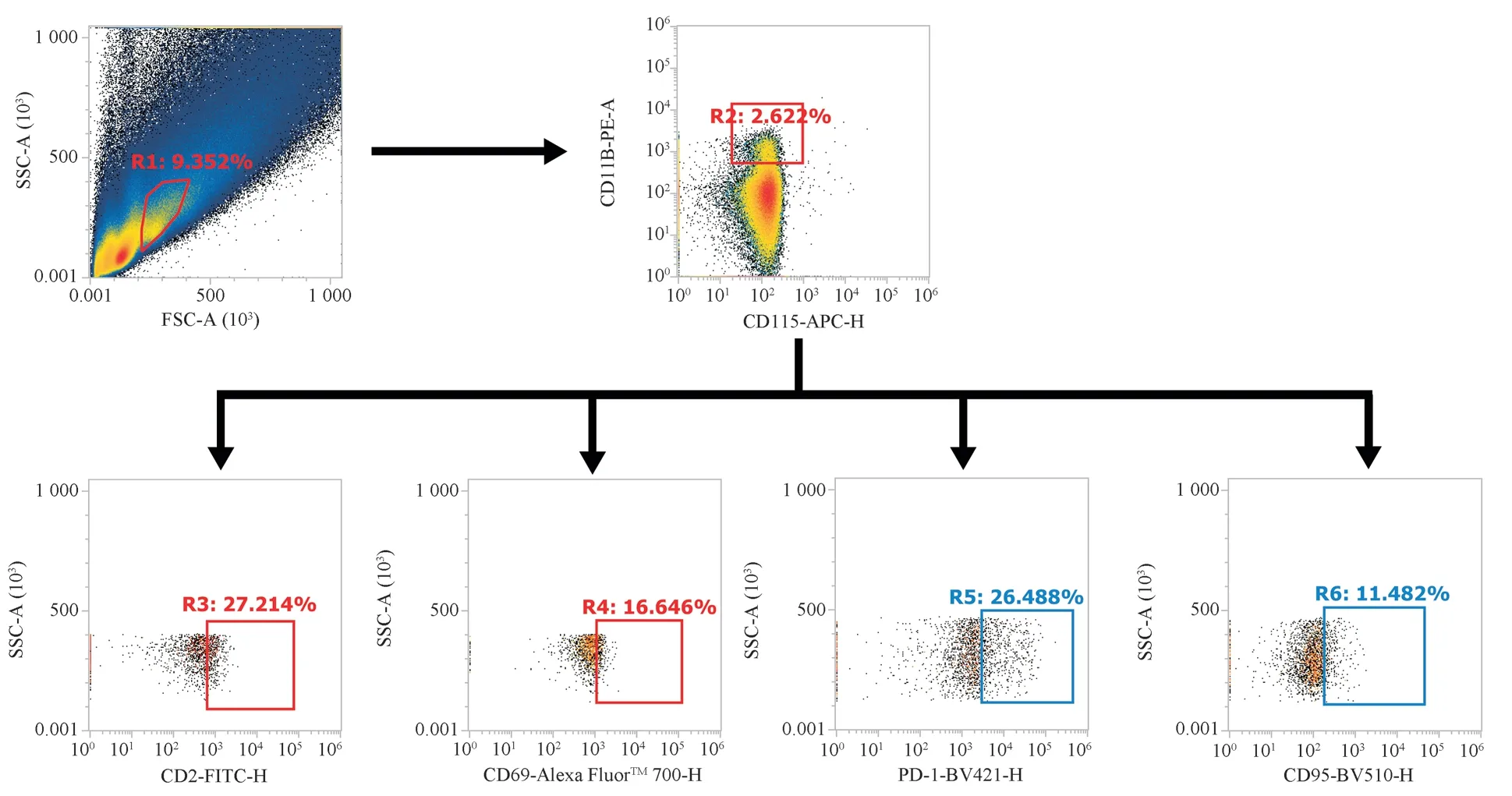
Fig 1 Door setting strategy

Fig 2 Expression of CD2 and CD69 on the surface of CD11b + cells in peripheral blood of mice
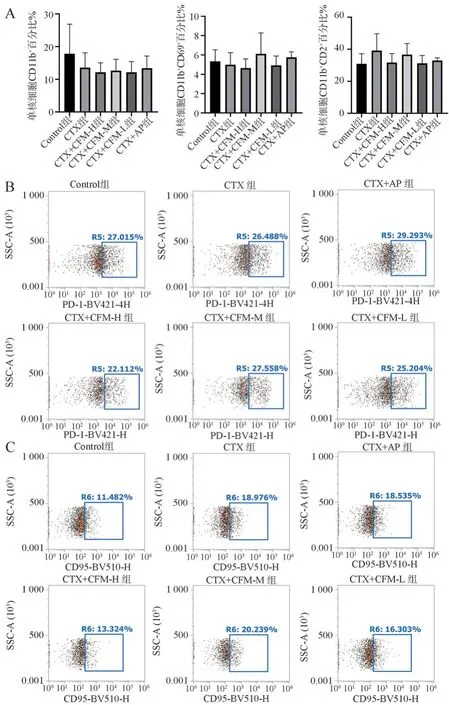
Fig 3 The expression of PD-1 and CD95 on CD11b + cells in peripheral blood of mice.

Tab 1 Percentages of CD2 and CD69 subsets on CD11b + cells in peripheral blood of mice
There was no statistical difference between each group and the model group.There was no statistical difference between each group and the control.
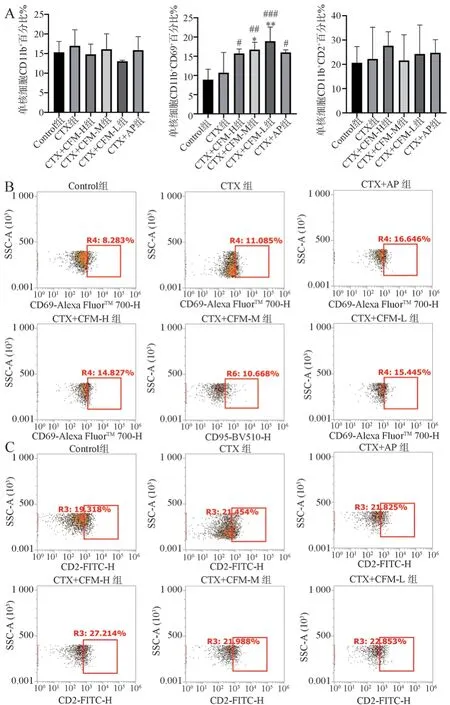
Fig 4 Expression of CD2 and CD69 on the surface of CD11b + cells in mouse spleen
3.3 The expression of CD2 and CD69 on the surface of CD11b + cells in mouse spleen
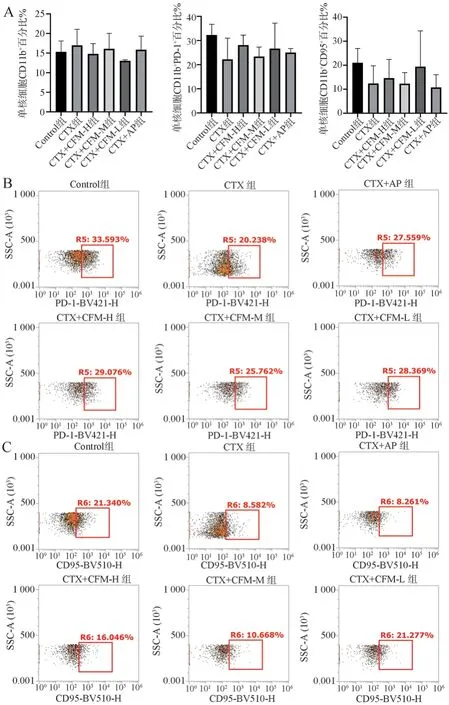
Fig 5 The expression of PD-1 and CD95 on the surface of CD11b + cells in mouse spleen.
As shown in Fig.4 and Table 3, there was no significant difference in the ratio of CD11b+ monocytes in mouse spleen tissue between the groups ( P > 0.05 ).The percentage of CD11b+CD69+monocytes in CTX + CFM-M group and CTX + CFM-L group was significantly higher than that in CTX group ( P = 0.043 4, P = 0.003 0 ).The percentage of CD11b+CD69+monocytes in experimental group and positive control group was significantly higher than that in Control, and the ratio decreased with the increase of CFM dose, suggesting that CFM could improve the symptoms of low expression of CD11b+monocytes in spleen tissue of mice induced by cyclophosphamide.Compared with CTX group, the expression level of CD11b+CD2+monocytes in CTX + CFM-M group decreased but there was no statistical difference ( P > 0.05 ).The expression level of CD11b+CD2+monocytes in CTX + CFM-H group, CTX + CFM-L group and CTX + AP group showed an upward trend ( P = 0.999 9, P =0.940 1, P = 0.999 3, P = 0.998 0 ).
3.4 The expression of PD-1 and CD95 on the surface of CD11b+ cells in mouse spleen
As shown in Fig.5 and Table 4, the expression levels of CD95 and PD-1 on CD11b+monocytes in spleen tissue were similar.The expression levels of CD95 and PD-1 in CTX + CFM-H group,CTX + CFM-M group, CTX + CFM-L group and CTX + AP group were higher than those in CTX group, but there was no statistical significance ( P > 0.05 ).
There was no statistical difference between each group and the model group.There was no statistical difference between each group and the control.

Tab 2 Percentages of PD-1 and CD95 subsets on CD11b + cells in peripheral blood of mice

Tab 3 Percentages of CD2 and CD69 subsets on CD11b + cells in mouse spleen

Tab 4 Percentage of CD11b + cell surface depletion molecules PD-1 and CD95 subsets in mouse spleen
4.Discussions
Low immune function is one of the important guiding conditions for the occurrence and development of diseases.Compound Euonymus fortunei mixture is composed of Euonymus fortunei, Astragalus membranaceus and Red ginseng.Modern pharmacological studies have shown that Euonymus fortunei has the effects of improving immune function, anti-oxidation and antiaging[14-18].In clinical practice, it is often used to treat postoperative tumor patients and AIDS and other immune dysfunction and other related diseases.However, the role of immune cells and the mechanism of regulating immune function still need to be explored.Cyclophosphamide-induced immunosuppressive mouse model is a commonly used experimental animal model of immunosuppression.Its immunosuppressive effect is related to the up-regulation of some immune negative regulatory molecules[19-21].Our previous study found that CFM can not only increase the percentage of NK cells, but also up-regulate the expression of CD69+on CD3-CD49b+NK cells in peripheral blood of mice[10], which has the effect of enhancing immune regulation.
Monocytes, as an important part of the body’s defense system,participate in the cellular immune response.After engulfing the antigen, the antigenic determinants carried by monocytes are presented to lymphocytes to induce lymphocyte-specific immune response[22,23].In this study, the immune model of mice was prepared by CTX, and the expression levels of CD2, CD69, PD-1 and CD95 on the surface of CD11b+monocytes in spleen and peripheral blood of immunosuppressed mice were detected by flow cytometry, in order to explore the immunomodulatory mechanism of CFM on monocytes in immunosuppressed mice.
The results showed that CFM played a role in restoring the ratio of CD11b+ monocytes in spleen tissue, but there was no significant difference in the ratio of CD11b+monocytes in peripheral blood.In the expression of exhaustion-related molecules, the expression of CD95 and PD-1 in CD11b+monocytes in peripheral blood and spleen tissues of mice was similar, and there was no significant difference between the groups.In the detection of surface activationrelated molecular expression, compared with the Control and the CTX group, the expression level of CD11b+CD2+monocytes in the spleen tissue of all drug intervention groups showed an upward trend, and there was no significant difference compared with the Control group.There was no significant difference in the expression of CD11b+CD2+monocytes among peripheral blood groups,suggesting that CFM may have the effect of restoring the expression of CD11b+CD2+monocytes in spleen tissue.There was no significant change in the expression of CD69 in spleen CD11b+ monocytes between the Control and the CTX group, but the expression of CD69 in CD11b+monocytes in all drug intervention groups was significantly higher than that in the Control and the CTX group,and the expression increased with the CFM concentration gradient.Modern studies have shown that CD69 has immunomodulatory effects[24,25].CD69 can restore immune function by regulating the balance of T cells.Therefore, we speculate that CFM may restore the ratio of CD11b+monocytes in spleen tissue by increasing the expression of CD69.There are many studies on CD69 in lymphocytes, but few on the expression of CD69 in monocytes.This study enriches the findings in this field.
In summary, this study preliminarily clarified the regulatory effect of CFM on monocytes, but its specific mechanism remains to be elucidated.Further research is planned from the perspective of cell signal transduction and nuclear transcription factors.
The author ‘s contribution shows :
Ding Jian : Article Writing, First and Correspondent Author.Chen Guo and Li Jianming : sample collection and preparation.Li Kaiqi and Yang Chenyi : flow on-line monitoring.Wu Yuerong : data analysis.
All authors do not have a conflict of interest.
杂志排行
Journal of Hainan Medical College的其它文章
- Effects of Tribulus terrestris saponins on proliferation and invasion of A549 cells
- The mechanism of regulating macrophage polarization based on Notch1 signaling pathway to improve joint inflammation in adjuvant arthritis rats
- Mechanism of Sanshi decoction in the treatment of gouty arthritis by NLRP3 inflammasome
- Predictive value of controlling nutritional status score for progression to chronic critical illness in elderly patients with sepsis
- SPHK1 expression in gastric cancer and clinical value based on bioinformatics analysis
- Meta-analysis of the effects of high-intensity intermittent exercise on cardiopulmonary function rehabilitation in patients with stroke
